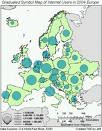
Range Graded Proportional Circle Map: Range graded proportional circle map: a proportional circle map that depicts the data in relation to ranges of data. The information is classified as equal quantiles, breaks, natural breaks, and minimum variance. . Range-graded scaling: The data are divided into groups, using classification procedures common to choropleth mapping. The design goal is for symbol size discrimination, rather than magnitude estimation. The cartographer chooses symbol sizes for adjacent classes so that the map reader can easily distinguish between circle sizes, and therefore, categories. Only a set number of circle sizes are used.







